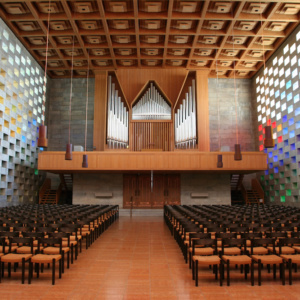Sound treatment is critical in faith and worship centers, as these locations tend to rely heavily on both speech and music. The centers must be properly outfitted with acoustical equipment to increase speech intelligibility while simultaneously enhancing the quality of musical components.
The equal importance of music and speech quality creates a challenge for architects and consultants working to achieve proper hearing conditions in worship centers. Consider these guidelines when working on worship center acoustics to create the perfect balance.
For a more detailed Worship Space acoustic assessment, see our Church Acoustical Case Studies here.
Acoustic Design for Churches and Worship Centers
Floor Plans for Churches
Develop a narrow floor plan with a high room volume to support lateral sound. In wider plans, sound tends to feel as though it is coming from far-away, which hurts acoustics. The entire audience should be within a 150-degree direction of the speaker, so that there are not “dead areas” at the edges of the front rows, where it is difficult to hear the preacher speak.
Elevate Pulpits
Pulpits, podiums, lecterns or any other platform on which a speaker or performer stands, should be raised and near a wall. This allows the congregation to have direct line-of-sight with the speaker. The platform should be raised enough so that viewers can see the speaker, which generally requires a 4-5″ view line above the preceding row or pew.
In some cases, especially for large churches and those that do not have reinforced sound systems, a pulpit reflector may be needed. This is a dense, reflective surface angled towards the congregation that helps to reinforce the speaker’s voice.
Avoid Concave Ceilings
Ceilings should not contain any type of dome or other concave shapes. These types of shapes focus sound energy, weakening volume for those in the back of the church. Many churches also struggle with “Creep Echo” due to ceiling concavity. In those cases, the sound waves bounce along the edge of the dome. This results in long reverberation times within the church.
Church Seating
Seats should be arranged as close to the speaker’s platform as possible. Carpets and cushioning can be used in seating areas to improve absorption as well as reduce foot-traffic noise.
Sound Reflecting Materials
Any new building should be completed with sound reflecting materials such as concrete or thick plaster. Include multiple irregularities like bumps and indents to improve reverberance, diffusion and lateral reflections.
Church Music
The choir, organ, and organ console (if present) should be clustered together to create balance. Refrain from using carpeting, cushioning and other sound absorbing materials in the choir area, which would absorb and reduce the sound prior to emanating out into the broader church area.
Minimize Background Noise
Mechanical noise can be seriously problematic during meditation, prayer and other silent moments in the worship center. Mechanical systems and pipes should be outfitted with soundproofing material and quieter systems should be installed when possible.
Speaker Systems
A central electronic sound-reinforcing system should be installed to enhance speech intelligibility and ensure the sound comes from the speaker’s location to create a sense of unity.
Proper speech intelligibility combined with musical clarity helps to create the ideal worship center environment. Consider these guidelines the next time you provide acoustical consulting or treatment to a worship center.
Did one of these ideas help you with a project? Let us know in the comments below!



